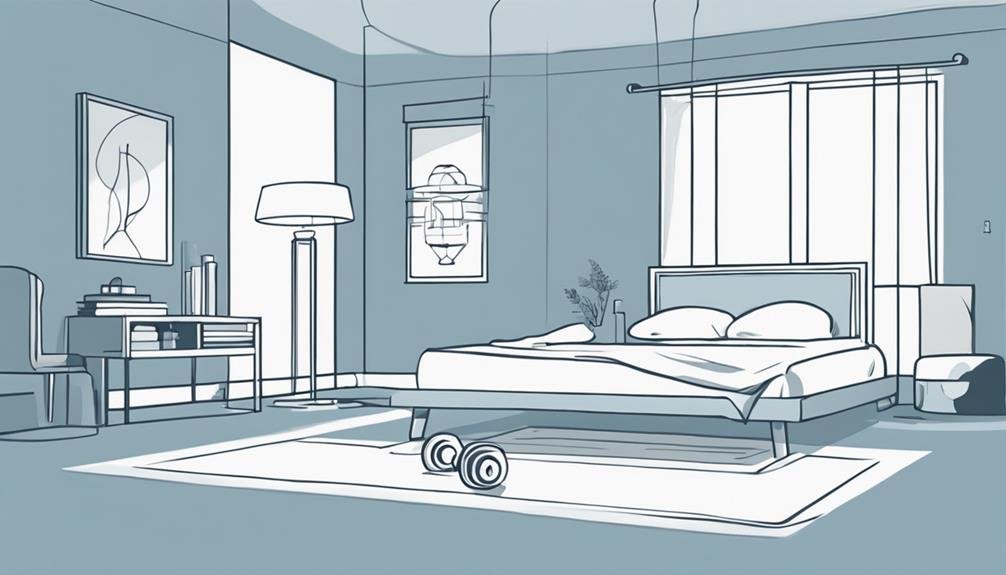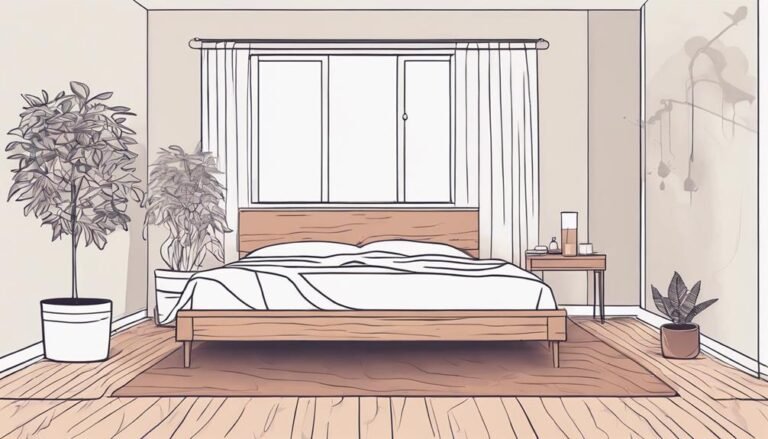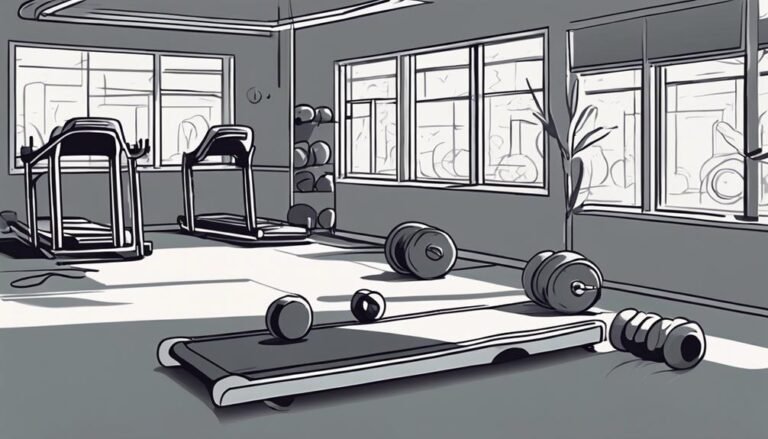10 Bedtime Stretches for Fit Men Over 40
Incorporating bedtime stretches into your routine is essential for maintaining fitness and mobility after 40. Focus on key stretches like the hamstring, hip flexor, chest opener, and spinal twist to enhance flexibility and relieve tension. Make sure you hold each stretch for 15-30 seconds while breathing deeply to maximize benefits. Creating a calming environment—think dim lights and comfortable mats—can improve your stretching experience. Most importantly, start slow and listen to your body to prevent injury. If you're keen to discover more specific stretches and techniques tailored for you, there's plenty more to explore!
Key Takeaways
- Incorporate hamstring and hip flexor stretches to enhance leg mobility and alleviate tension after a long day.
- Utilize chest opener stretches to improve posture and relieve tightness from prolonged sitting.
- Perform spinal twist stretches for increased flexibility and stress relief, promoting relaxation before sleep.
- Engage in calf stretches to maintain lower leg flexibility and enhance muscle recovery overnight.
Importance of Stretching Before Sleep
Stretching before sleep helps relax your muscles and can improve your overall quality of rest. When you take just a few minutes to stretch, you signal to your body that it's time to unwind. This practice reduces muscle tension and increases blood flow, which helps eliminate the stress accumulated throughout the day.
Incorporating gentle stretches into your nighttime routine can also enhance your flexibility and range of motion, making everyday activities easier. Plus, it gives you a moment of mindfulness, allowing you to focus on your breathing and clear your mind.
Benefits of Stretching for Men Over 40
As you unwind and prepare for sleep, incorporating stretching into your routine offers numerous benefits specifically for men over 40, helping to maintain flexibility and prevent injury.
Stretching not only enhances your physical performance but also promotes a sense of relaxation, making it easier to drift off to sleep. Additionally, you'll find that regular stretching can alleviate muscle tension and improve your overall range of motion.
Here are some key benefits of stretching for men over 40:
- Increased flexibility: Helps maintain mobility in joints and muscles.
- Reduced risk of injury: Improves muscle elasticity and resilience.
- Enhanced relaxation: Aids in calming the mind and body before sleep.
Preparing Your Space for Stretching
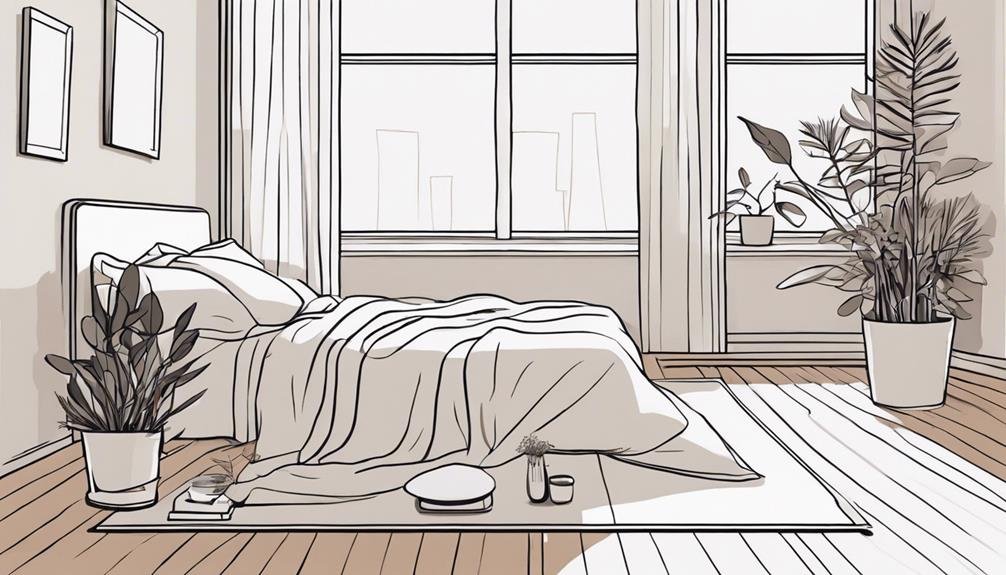
Create a calming environment by decluttering your space and dimming the lights to set the mood for your bedtime stretches. A peaceful atmosphere helps you focus and unwind. Consider adding soft music or nature sounds to enhance relaxation.
| Essential Item | Purpose |
|---|---|
| Yoga Mat | Provides comfort and grip |
| Pillows/Blankets | Supports your stretches |
| Essential Oils | Promotes relaxation |
Before you start, ascertain the area is free from distractions. You want to create a sanctuary where you can fully relax and connect with your body. By preparing your space thoughtfully, you'll make your bedtime stretching routine more enjoyable and effective.
Stretching Safety Tips
To guarantee a safe and effective stretching routine, listen to your body and avoid pushing yourself into painful positions. Understand that stretching should feel good, not painful.
Start slowly, especially if you're new to stretching, and gradually increase your range of motion. Remember to breathe deeply and relax as you stretch; this helps prevent muscle tension and enhances flexibility.
Here are some safety tips to keep in mind:
- Warm up your muscles with light activity before stretching.
- Hold each stretch for 15-30 seconds without bouncing.
- Stay hydrated to maintain muscle elasticity.
Hamstring Stretch
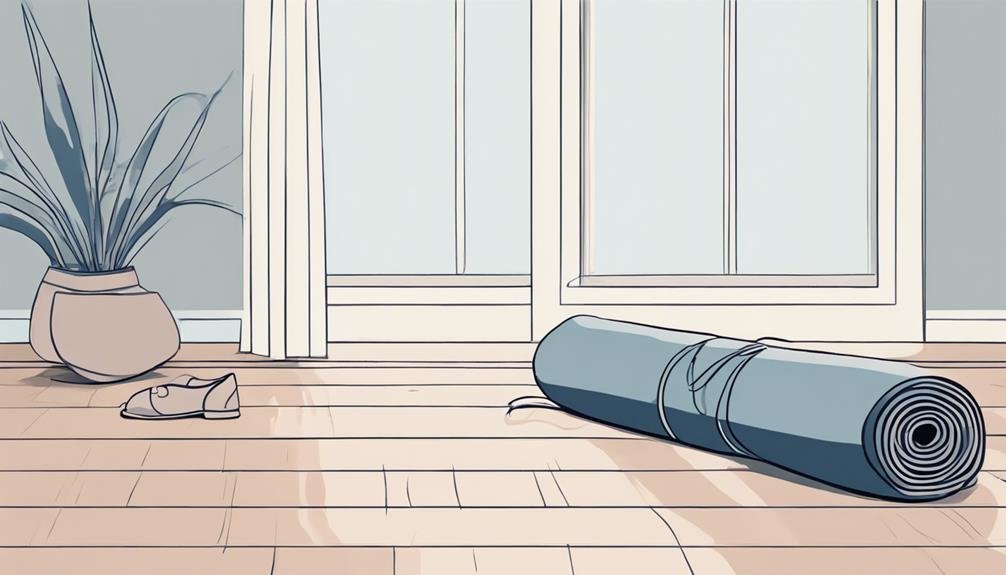
Stretch your hamstrings gently to improve flexibility and alleviate tension in the back of your legs. Start by sitting on the floor with your legs extended in front of you. Slowly reach forward, keeping your back straight, until you feel a stretch. Hold this position for 15-30 seconds, then release. Repeat 2-3 times for best results.
| Step | Action | Duration |
|---|---|---|
| 1 | Sit with legs extended | – |
| 2 | Reach forward | 15-30 seconds |
| 3 | Hold the stretch | 2-3 repetitions |
| 4 | Relax and breathe | – |
Incorporate this stretch into your nightly routine to support better mobility as you age.
Hip Flexor Stretch
Hip flexor stretches can greatly improve your mobility and reduce tightness in your hips, especially after a long day of sitting. Taking just a few minutes before bed to focus on this area can make a significant difference in how you feel.
Here's how to perform an effective hip flexor stretch:
- Kneel on one knee: Position yourself with one knee on the ground and the other foot in front.
- Shift your weight forward: Gently push your hips forward while keeping your back straight.
- Hold the stretch: Maintain this position for 20-30 seconds, feeling the stretch in the hip flexor of the kneeling leg.
Incorporating this stretch into your routine will enhance flexibility and comfort.
Chest Opener Stretch

A chest opener stretch can relieve tension and improve your posture, especially after hours spent hunched over a desk.
To perform this stretch, stand tall with your feet hip-width apart. Interlace your fingers behind your back, palms facing in. As you inhale, gently pull your shoulders back and down while lifting your hands away from your body.
Feel the stretch across your chest and shoulders. Hold this position for 20 to 30 seconds, breathing deeply. Make sure to keep your neck relaxed and avoid arching your lower back. You can also perform this stretch seated if that feels more comfortable.
Incorporating this stretch into your bedtime routine will leave you feeling more relaxed and open, setting the stage for a restful night.
Spinal Twist Stretch
Incorporating a spinal twist into your bedtime routine can enhance flexibility and relieve tension in your back. This stretch targets your spine and hips, helping to release the built-up stress from your day.
To perform the spinal twist, follow these steps:
- Sit on the floor with your legs extended.
- Bend your right knee, placing your foot outside your left thigh.
- Rotate your torso to the right, using your left arm to press against your right knee.
You'll find that regularly practicing this stretch improves your mobility and promotes relaxation, making it easier to unwind before sleep.
Make it a habit, and enjoy the benefits!
Calf Stretch
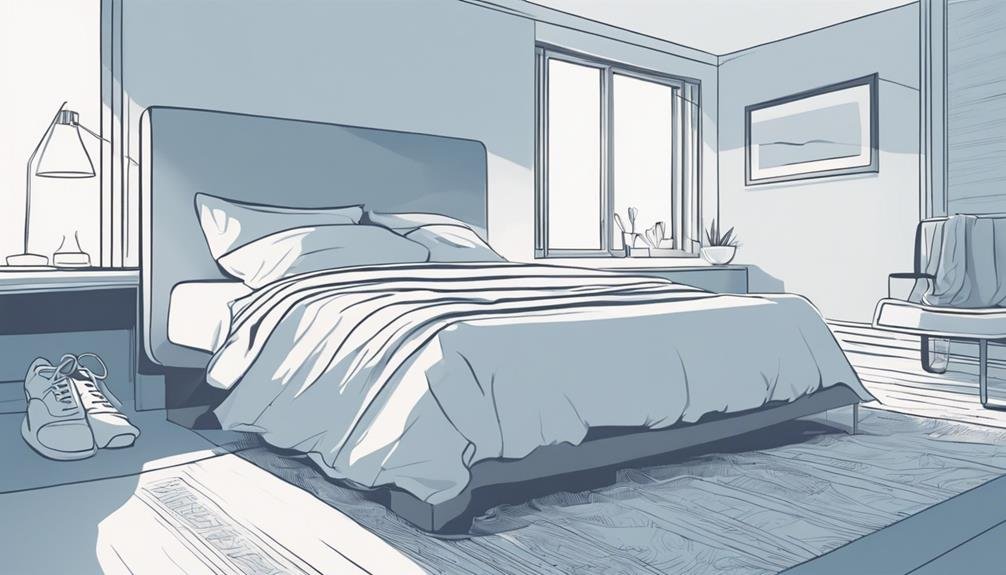
Stretching your calves before bed can relieve tightness and improve flexibility, making it easier to relax after a long day.
To perform a calf stretch, stand facing a wall with your hands pressed against it at shoulder height. Step one foot back, keeping it straight, while bending the front knee. Make sure your back heel stays on the ground. You'll feel the stretch in your back calf. Hold this position for 15-30 seconds, then switch legs.
For a deeper stretch, try the seated calf stretch: sit on the floor with legs extended, loop a towel around the ball of one foot, and gently pull towards you. Repeat on the other side.
Enjoy the benefits of relaxed calves for a restful night's sleep!
Incorporating Breathing Techniques
Breathing techniques can enhance your bedtime stretches, helping you relax both your mind and body for a better night's sleep.
By incorporating focused breathing, you can improve your flexibility, reduce tension, and promote a sense of calm.
Here's how to integrate these techniques effectively:
- Inhale deeply through your nose, allowing your abdomen to expand fully.
- Exhale slowly through your mouth, releasing any tension with each breath out.
- Synchronize your breath with your movements, inhaling during stretches and exhaling as you deepen them.
Questions
Can Stretching Help With Sleep Apnea Symptoms?
Stretching can improve overall muscle relaxation, which may help reduce tension. While it won't directly cure sleep apnea, incorporating stretches into your routine might contribute to better sleep quality and overall well-being.
How Long Should Each Stretch Be Held?
How long do you think you should hold each stretch for maximum benefit? Ideally, hold each stretch for 15 to 30 seconds. This duration allows your muscles to relax, enhancing flexibility and promoting overall relaxation.
Is It Safe to Stretch With Injuries?
Stretching with injuries can be risky. You should listen to your body; if it hurts, stop. Consulting a healthcare professional is wise to guarantee you're not exacerbating your injury while trying to maintain flexibility.
Can Stretching Improve Athletic Performance?
Imagine a sprinter who incorporates dynamic stretching before races. You'll find that stretching can enhance your athletic performance by improving flexibility, increasing blood flow, and preparing your muscles for the demands of intense activity.
What Time of Day Is Best for Stretching?
The best time for stretching depends on your schedule and goals. Mornings can energize you, while evenings help relax your muscles. Listen to your body and choose a time that feels right for you.
Conclusion
Incorporating these bedtime stretches can notably enhance your flexibility and overall well-being.
Did you know that men over 40 can lose up to 1% of their flexibility each year?
By dedicating just a few minutes each night to stretching, you can counteract this decline and improve your mobility.
So, roll out your mat, focus on your breathing, and enjoy the benefits of a more relaxed body and mind before you drift off to sleep.

